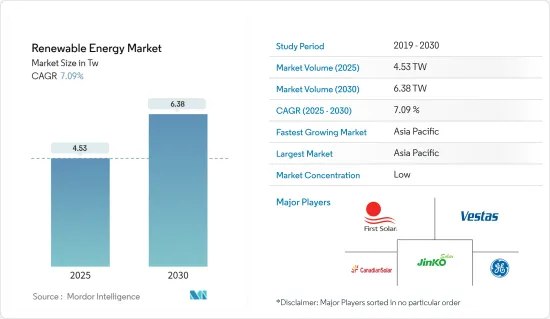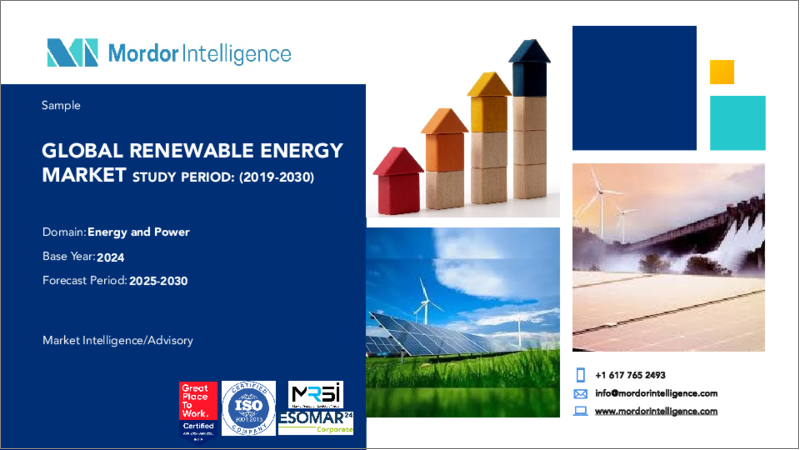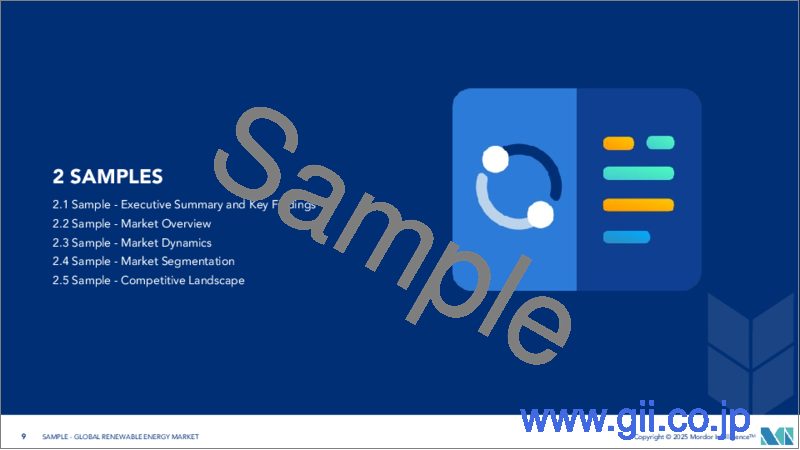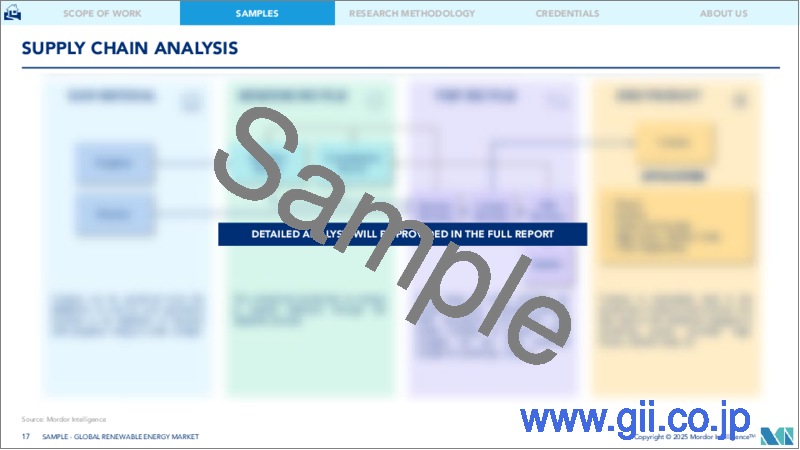|
|
市場調査レポート
商品コード
1687252
再生可能エネルギー- 市場シェア分析、産業動向・統計、成長予測(2025年~2030年)Renewable Energy - Market Share Analysis, Industry Trends & Statistics, Growth Forecasts (2025 - 2030) |
||||||
カスタマイズ可能
適宜更新あり
|
|||||||
価格
| 再生可能エネルギー- 市場シェア分析、産業動向・統計、成長予測(2025年~2030年) |
|
出版日: 2025年03月18日
発行: Mordor Intelligence
ページ情報: 英文 125 Pages
納期: 2~3営業日
|
- 全表示
- 概要
- 目次
概要
再生可能エネルギー市場規模は2025年に453億円と推定され、予測期間中(2025~2030年)のCAGRは7.09%で、2030年には63億8,000万円に達すると予測されます。

主要ハイライト
- 長期的には、再生可能エネルギーに対する政府の有利な施策、ソーラーパネルと風力タービンの設置価格の下落が市場の主要促進要因になると考えられます。
- しかし、発電用天然ガスの普及拡大が再生可能エネルギー発電市場の成長を妨げると予想されます。
- 世界的に意欲的な再生可能エネルギー目標は、調査された市場に大きな機会を提供すると予想されます。
- アジア太平洋は、中国とインドからの主要需要により、予測期間中に最も急成長する市場になると予想されます。
再生可能エネルギー市場動向
予測期間中、水力発電セグメントが市場を独占する見込み
- 水力発電は、標高の高いところから低いところへ移動する水のエネルギーから電力を得る再生可能エネルギーです。水力発電プロジェクトは、農業、家庭、企業にきれいな水を供給し、洪水や干ばつなどの異常気象の影響を緩和します。
- 水力発電は、世界的に見ても再生可能な電力の唯一最大の供給源です。2022年には、水力発電による再生可能エネルギー発電は再生可能エネルギー全体の41%近くを占め、世界の再生可能エネルギー発電の中で水力発電の貢献が最大となります。
- 国際再生可能エネルギー機関によると、2022年の世界の水力発電設備容量は1,393ギガワット(GW)に達し、2021年比で2.19%増加しました。水力発電の設備容量は、今後の水力発電プロジェクトと技術の進歩によって増加すると予想されます。
- 2022年8月、マサチューセッツ工科大学(MIT)の同窓生兄弟によって設立されたNatel Energyは、魚に安全なタービンなど、自然の川の状態を模倣した水力発電システムを開発しました。このようなエコフレンドリー開発により、水力発電セグメントの需要は予測期間中に増加すると予想されます。
- 2022年8月、インド政府はネパールにおける2つの水力発電プロジェクト、すなわち西セティ水力発電プロジェクトとセティ川水力発電プロジェクトの開発を発表しました。これらのプロジェクトの総事業費は約24億米ドルになる見込みです。
- したがって、予測期間中は水力発電セグメントが市場を独占すると予想されます。
予測期間中、アジア太平洋が市場を独占する見込み
- アジア太平洋は、近年再生可能エネルギー市場を独占しており、予測期間中もその支配力を維持すると考えられます。
- 2022年には、中国が再生可能エネルギー導入の世界的リーダーでした。同国の2022年の再生可能エネルギー総発電容量は1,160.8GWに達し、2021年と比較して約13.4%増加しました。水力、太陽光、風力が同国の主要な再生可能エネルギー源です。
- インドの電力需要は、経済成長と人口増加に伴い大幅に増加しました。2022年の水力発電量は162.96GWで、2021年の147.12GWから増加しました。
- また、インドは中国、米国に次ぐ世界第3位の電力消費国となりました。インドの純発電容量は過去10年間で大幅に増加し、その主要ものは大規模水力を含む再生可能エネルギーによるものです。
- インド政府は、2022年度までに再生可能エネルギー容量を1億7500万kW導入する目標を掲げており、その内訳は、太陽光発電が1億kW、風力発電が6,000万kW、バイオ発電が1,000万kW、小水力発電が500万kWです。インドの新・再生可能エネルギー省は、2022年に再生可能エネルギー、電気自動車、太陽光発電設備の製造、グリーン水素に150億米ドルの投資を見込んでいます。
- 2022年1月、SJVN(Satluj Jal Vidyut Nigam Ltd)は、ウッタル・プラデーシュ州新再生可能エネルギー開発庁(UPNEDA)の入札により、ウッタル・プラデーシュ州で125MWの太陽光発電プロジェクトを落札しました。このプロジェクトには、Jalaunにおける75MWの系統連系ソーラープロジェクトと、Kanpur Dehat地区における50MWのソーラープロジェクトが含まれます。
- 日本政府はまた、2030年までに二酸化炭素排出量を50%削減し、2050年までにカーボンニュートラルを達成することを目標としています。2022年9月、グリーンパワーインベストメント(GPI)は、青森県西津軽郡深浦町の深浦ウィンドファームの事業者としてGE Renewable Energyを選びました。GEの4.2-117陸上風力タービン19基を含むこのプロジェクトは、GEにとって日本で3件目となります。
- Amazonは2022年12月、インドのMacquarieのGreen Investment Group(GIG)のポートフォリオ会社の子会社であるVibrant Energyと、インド初の風力と太陽光のハイブリッドプロジェクトの1つを発表しました。この2つのプロジェクトは300メガワット(MW)の再生可能エネルギー容量に相当し、マディヤ・プラデシュ州とカルナータカ州に位置します。
- したがって、このような開発は、予測期間中にアジア太平洋の再生可能エネルギー市場を後押しすると予想されます。
再生可能エネルギー産業概要
再生可能エネルギー市場は細分化されています。同市場の主要企業(順不同)には、First Solar Inc.、Vestas Wind Systems AS、Canadian Solar Inc.、Jinko Solar Holding、General Electric Companyなどがあります。
その他の特典
- エクセル形式の市場予測(ME)シート
- 3ヶ月間のアナリストサポート
目次
第1章 イントロダクション
- 調査範囲
- 調査の前提条件
第2章 エグゼクティブサマリー
第3章 調査手法
第4章 市場概要
- イントロダクション
- 再生可能エネルギーミックス(2023年)
- 再生可能エネルギー設備容量と2029年までの予測
- 最近の動向と開発
- 政府の規制と施策
- 市場力学
- 促進要因
- 再生可能エネルギーに対する政府の好意的施策
- ソーラーパネルと風力タービンの価格低下
- 水力発電と揚水発電プロジェクトへの投資の増加
- 地熱エネルギーへの注目の高まり
- 抑制要因
- 発電用天然ガスの普及拡大
- 促進要因
- サプライチェーン分析
- ポーターのファイブフォース分析
- 供給企業の交渉力
- 消費者の交渉力
- 新規参入業者の脅威
- 代替品の脅威
- 競争企業間の敵対関係
第5章 市場セグメンテーション
- 市場タイプ
- 太陽電池
- 風力
- 水力
- バイオエネルギー
- その他のタイプ(地熱、潮力など)
- 地域
- 北米
- 米国
- カナダ
- その他の北米地域
- 欧州
- 英国
- ドイツ
- フランス
- スペイン
- ノルディック
- トルコ
- ロシア
- その他の欧州
- アジア太平洋
- 中国
- インド
- 日本
- マレーシア
- タイ
- インドネシア
- ベトナム
- その他のアジア太平洋
- 中東・アフリカ
- アラブ首長国連邦
- サウジアラビア
- エジプト
- ナイジェリア
- 南アフリカ
- カタール
- その他の中東・アフリカ
- 南米
- ブラジル
- アルゼンチン
- コロンビア
- その他の南米
- 北米
第6章 競合情勢
- M&A、合弁事業、提携、協定
- 主要企業の戦略
- 企業プロファイル
- EPCデベロッパー/事業者/所有者
- Orsted AS
- EDF SA
- NextEra Energy Inc.
- Duke Energy Corporation
- Berkshire Hathway Energy
- Acciona Energia SA
- 機器サプライヤー
- First Solar Inc.
- Vestas Wind Systems AS
- Canadian Solar Inc.
- Jinko Solar Holding Co. Ltd
- General Electric Company
- Siemens Gamesa Renewable Energy SA
- EPCデベロッパー/事業者/所有者
- 市場ランキング/シェア(%)分析
第7章 市場機会と今後の動向
- 世界各地の意欲的な再生可能エネルギー目標
目次
Product Code: 57156
The Renewable Energy Market size is estimated at 4.53 tw in 2025, and is expected to reach 6.38 tw by 2030, at a CAGR of 7.09% during the forecast period (2025-2030).

Key Highlights
- Over the long term, the major driving factors of the market are likely to be favorable government policies for renewable energy and declining prices of solar panels and wind turbine installations.
- However, the increasing penetration of natural gas for power generation is expected to hinder the renewable energy market's growth.
- The ambitious renewable energy targets worldwide are anticipated to provide huge opportunities for the market studied.
- Asia-Pacific is expected to be the fastest-growing market during the forecast period, with major demand from China and India.
Renewable Energy Market Trends
Hydropower Segment is Expected to Dominate the Market during the Forecast Period
- Hydroelectric power (hydropower) is a renewable energy source where electrical power is derived from the energy of water moving from higher to lower elevations. Hydropower projects supply clean water for agriculture, homes, and businesses and mitigate the impacts of extreme weather events such as floods and drought.
- Hydropower is the single largest source of renewable electricity globally. In 2022, renewable electricity generation from hydropower accounted for nearly 41% of total renewable energy, the largest contribution from hydropower in global renewable-based electricity generation.
- According to the International Renewable Energy Agency, in 2022, the global hydropower installed capacity reached 1,393 gigawatts (GW), representing a rise of 2.19% compared to 2021. The hydropower installed capacity is expected to grow with the upcoming hydro projects and technological advancements.
- In August 2022, Natel Energy, created by MIT alumni siblings, developed hydropower systems that included fish-safe turbines and other features that imitate natural river conditions. Thus, with such eco-friendly developments, the hydropower segment's demand is expected to increase during the forecast period.
- In August 2022, the Government of India announced the development of two hydropower projects in Nepal, namely the West Seti Hydropower Project and the Seti River Hydropower Project. The total cost of these projects is expected to be around USD 2.4 billion.
- Thus, the hydropower segment is expected to dominate the market during the forecast period.
Asia-Pacific is Anticipated to Dominate the Market during the Forecast Period
- Asia-Pacific has dominated the renewable energy market over recent years, and it is likely to maintain its dominance during the forecast period.
- In 2022, China was the global leader in renewable energy deployment. The country's total renewable energy capacity reached 1,160.8 GW in 2022, representing an increase of approximately 13.4% compared to 2021. Hydropower, solar, and wind are the major renewable energy sources in the country.
- India's power demand increased significantly in line with its expanding economy and growing population. In 2022, the country generated 162.96 GW of hydropower, up from 147.12 GW in 2021.
- India has also become the world's third-largest power consumer after China and the United States. India's net power generation capacity increased significantly in the last decade, majorly from renewable energy sources, including large hydro sources.
- The Government of India had set a target of installing 175 GW of renewable energy capacity by FY 2022, including 100 GW from solar, 60 GW from wind, 10 GW from biopower, and 5 GW from small hydropower. The Indian Ministry for New and Renewable Energy expected an investment of USD 15 billion in renewable energy, electric vehicles, manufacturing of solar equipment, and green hydrogen in 2022.
- In January 2022, SJVN (Satluj Jal Vidyut Nigam Ltd) bagged a solar project of 125 MW in Uttar Pradesh through a bidding process held by the Uttar Pradesh New and Renewable Energy Development Agency (UPNEDA). The project includes a 75 MW grid-connected solar project in Jalaun and a 50 MW solar project in Kanpur Dehat districts.
- The Japanese government has also targeted reducing carbon emissions to 50% by 2030 and achieving carbon neutrality by 2050. In September 2022, Green Power Investment (GPI) chose GE Renewable Energy as the provider for the Fukaura Wind Farm in Fukaura Town, Nishi Tsugaru District, Aomori Prefecture, Japan. The project, which will include 19 units of GE's 4.2-117 onshore wind turbines, is GE's third in Japan.
- In December 2022, Amazon announced one of its first wind-solar hybrid projects in India with Vibrant Energy, a subsidiary of a portfolio company of Macquarie's Green Investment Group (GIG), India. The two projects represent 300 megawatts (MW) of renewable energy capacity, and the projects are located in Madhya Pradesh and Karnataka.
- Hence, such developments are expected to boost the Asia-Pacific renewable energy market during the forecast period.
Renewable Energy Industry Overview
The renewable energy market is fragmented. Some of the major players in the market (in no particular order) are First Solar Inc., Vestas Wind Systems AS, Canadian Solar Inc., Jinko Solar Holding Co. Ltd, and General Electric Company.
Additional Benefits:
- The market estimate (ME) sheet in Excel format
- 3 months of analyst support
TABLE OF CONTENTS
1 INTRODUCTION
- 1.1 Scope of the Study
- 1.2 Study Assumptions
2 EXECUTIVE SUMMARY
3 RESEARCH METHODOLOGY
4 MARKET OVERVIEW
- 4.1 Introduction
- 4.2 Renewable Energy Mix, 2023
- 4.3 Renewable Energy Installed Capacity and Forecast till 2029
- 4.4 Recent Trends and Developments
- 4.5 Government Policies and Regulations
- 4.6 Market Dynamics
- 4.6.1 Drivers
- 4.6.1.1 Favorable Government Policies for Renewable Energy
- 4.6.1.2 The Declining Price of Solar Panels and Wind Turbine Installations
- 4.6.1.3 Increasing Investments in Hydropower and Pumped Storage Hydropower Projects
- 4.6.1.4 Growing Emphasis on Geothermal Energy
- 4.6.2 Restraints
- 4.6.2.1 Increasing Penetration of Natural Gas for Power Generation
- 4.6.1 Drivers
- 4.7 Supply Chain Analysis
- 4.8 Porter's Five Forces Analysis
- 4.8.1 Bargaining Power of Suppliers
- 4.8.2 Bargaining Power of Consumers
- 4.8.3 Threat of New Entrants
- 4.8.4 Threat of Substitutes Products and Services
- 4.8.5 Intensity of Competitive Rivalry
5 MARKET SEGMENTATION
- 5.1 Type
- 5.1.1 Solar
- 5.1.2 Wind
- 5.1.3 Hydro
- 5.1.4 Bioenergy
- 5.1.5 Other Types (Geothermal, Tidal, etc.)
- 5.2 Geography
- 5.2.1 North America
- 5.2.1.1 United States of America
- 5.2.1.2 Canada
- 5.2.1.3 Rest of the North America
- 5.2.2 Europe
- 5.2.2.1 United Kingdom
- 5.2.2.2 Germany
- 5.2.2.3 France
- 5.2.2.4 Spain
- 5.2.2.5 NORDIC
- 5.2.2.6 Turkey
- 5.2.2.7 Russia
- 5.2.2.8 Rest of the Europe
- 5.2.3 Asia-Pacific
- 5.2.3.1 China
- 5.2.3.2 India
- 5.2.3.3 Japan
- 5.2.3.4 Malaysia
- 5.2.3.5 Thailand
- 5.2.3.6 Indonesia
- 5.2.3.7 Vietnam
- 5.2.3.8 Rest of Asia-Pacific
- 5.2.4 Middle East and Africa
- 5.2.4.1 United Arab Emirates
- 5.2.4.2 Saudi Arabia
- 5.2.4.3 Egypt
- 5.2.4.4 Nigeria
- 5.2.4.5 South Africa
- 5.2.4.6 Qatar
- 5.2.4.7 Rest of the Middle East and Africa
- 5.2.5 South America
- 5.2.5.1 Brazil
- 5.2.5.2 Argentina
- 5.2.5.3 Colombia
- 5.2.5.4 Rest of the South America
- 5.2.1 North America
6 COMPETITIVE LANDSCAPE
- 6.1 Mergers and Acquisitions, Joint Ventures, Collaborations, and Agreements
- 6.2 Strategies Adopted by Leading Players
- 6.3 Company Profiles
- 6.3.1 EPC Developers/Operators/Owners
- 6.3.1.1 Orsted AS
- 6.3.1.2 EDF SA
- 6.3.1.3 NextEra Energy Inc.
- 6.3.1.4 Duke Energy Corporation
- 6.3.1.5 Berkshire Hathway Energy
- 6.3.1.6 Acciona Energia SA
- 6.3.2 Equipment Suppliers
- 6.3.2.1 First Solar Inc.
- 6.3.2.2 Vestas Wind Systems AS
- 6.3.2.3 Canadian Solar Inc.
- 6.3.2.4 Jinko Solar Holding Co. Ltd
- 6.3.2.5 General Electric Company
- 6.3.2.6 Siemens Gamesa Renewable Energy SA
- 6.3.1 EPC Developers/Operators/Owners
- 6.4 Market Ranking/Share (%) Analysis
7 MARKET OPPORTUNITIES AND FUTURE TRENDS
- 7.1 Ambitious Renewable Energy Targets across the World
お電話でのお問い合わせ
044-952-0102
( 土日・祝日を除く )






